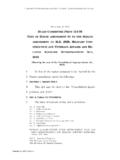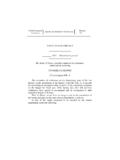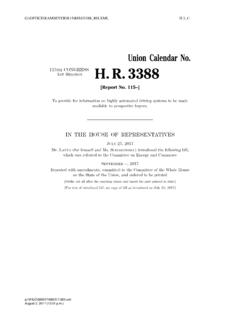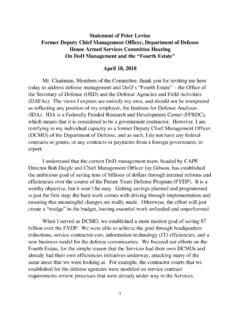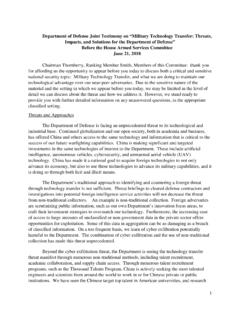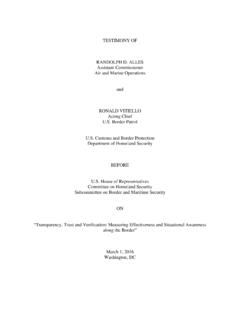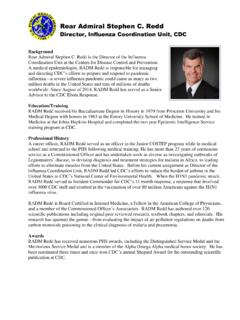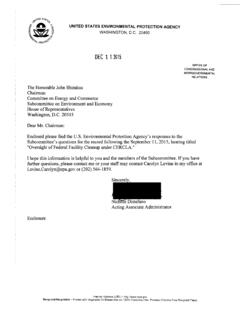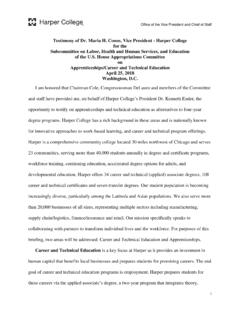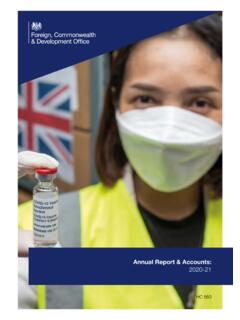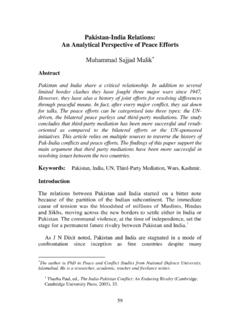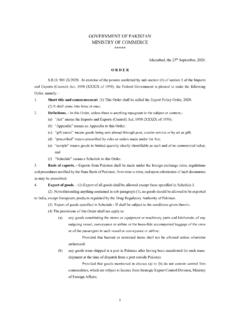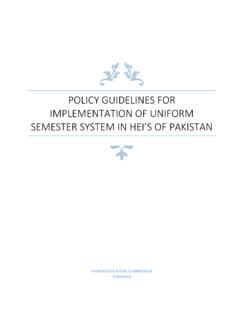Transcription of Month 00, 202X
1 Month 00, 202X. [1]. With Information as of January 2022. ANNUAL THREAT ASSESSMENT. OF THE INTELLIGENCE COMMUNITY. February 7, 2022. INTRODUCTION. This annual report of worldwide threats to the national security of the United States responds to Section 617 of the FY21 Intelligence Authorization Act ( 116-260). This report reflects the collective insights of the Intelligence Community (IC), which is committed every day to providing the nuanced, independent, and unvarnished intelligence that policymakers, warfighters, and domestic law enforcement personnel need to protect American lives and America's interests anywhere in the world. This assessment focuses on the most direct, serious threats to the United States during the next year. The order of the topics presented in this assessment does not necessarily indicate their relative importance or the magnitude of the threats in the view of the IC.
2 All require a robust intelligence response, including those where a near-term focus may help head off greater threats in the future, such as climate change and environmental degradation. As required by the law, this report will be provided to the congressional intelligence committees as well as the committees on the Armed Services of the House of Representatives and the Senate. Information available as of 21 January was use d in the pr eparation of this assessment. [2]. C O N TE N T S. INTRODUCTION .. 2. FOREWORD .. 4. CHINA .. 6. RUSSIA .. 10. IRAN .. 14. NORTH KOREA .. 16. HEALTH SECURITY .. 18. Infectious Diseases and the Impact of the COVID-19 Pandemic .. 18. Biological Weapons .. 19. Anomalous Health 20. CLIMATE CHANGE AND ENVIRONMENTAL DEGRADATION .. 21. ADDITIONAL TRANSNATIONAL ISSUES .. 22. Preface .. 22. Innovative Use of New Technology.
3 22. Transnational Organized Crime .. 23. foreign Illicit Drugs .. 23. Money Laundering and Financial Crimes .. 24. Cyber 24. 24. Global 25. CONFLICTS AND INSTABILITY .. 28. South Asia .. 28. Other Regions .. 29. [3]. FOR EWOR D. In the coming year, the United States and its allies will face an increasingly complex and interconnected global security environment marked by the growing specter of great power competition and conflict, while collective, transnational threats to all nations and actors compete for our attention and finite resources. These challenges will play out amidst the continued global disruption resulting from the COVID-19. pandemic, contention over global efforts to deal with a changing climate, increasingly powerful non-state actors, and rapidly evolving technology, all within the context of an evolving world order where the continued diffusion of power is leading actors to reassess their place and capabilities in an increasingly multipolar world.
4 These challenges will intersect and interact in unpredictable ways, leading to mutually reinforcing effects that could challenge our ability to respond, but also introducing new opportunities to forge collective action with allies and partners against both the renewed threat of nation-state aggression and emerging threats to human security. The 2022 Annual Threat Assessment highlights some of those connections as it provides the Intelligence Community's (IC's) baseline assessments of the most pressing threats to national interests, while emphasizing the United States' key adversaries and competitors. It is not an exhaustive assessment of all global challenges and notably excludes assessments of adversaries' vulnerabilities. It accounts for functional concerns, such as weapons of mass destruction and cyber, primarily in the sections on threat actors, such as China and Russia.
5 Competition and potential conflict between nation-states remains a critical national security threat. Beijing, Moscow, Tehran, and Pyongyang have demonstrated the capability and intent to advance their interests at the expense of the United States and its allies. China increasingly is a near-peer competitor, challenging the United States in multiple arenas especially economically, militarily, and technologically and is pushing to change global norms and potentially threatening its neighbors. Russia is pushing back against Washington where it can locally and globally employing techniques up to and including the use of force. In Ukraine, we can see the results of Russia's increased willingness to use military threats and force to impose its will on neighbors. Iran will remain a regional menace with broader malign influence activities, and North Korea will expand its WMD capabilities while being a disruptive player on the regional and world stages.
6 Major adversaries and competitors are enhancing and exercising their military, cyber, and other capabilities, raising the risks to and allied forces, weakening our conventional deterrence, and worsening the longstanding threat from weapons of mass destruction. As states such as China and Russia increasingly see space as a warfighting domain, multilateral space security discussions have taken on greater importance as a way to reduce the risk of a confrontation that would affect every state's ability to safely operate in space. The lingering effects of the COVID-19 pandemic will continue to strain governments and societies, fueling humanitarian and economic crises, political unrest, and geopolitical competition as countries, such as China and Russia, seek advantage through such avenues as vaccine diplomacy. No country has been completely spared, and even when a vaccine is widely distributed globally, the economic and political aftershocks will be felt for years.
7 Low-income countries with high debts face particularly challenging recoveries and the potential for cascading crises leading to regional instability, whereas others will turn inward or be distracted by other challenges. The IC continues to investigate the concerning incidences of Anomalous Health Incidents and the danger they pose to personnel. [4]. Ecological degradation and a changing climate will continue to fuel disease outbreaks, threaten food and water security, and exacerbate political instability and humanitarian crises. Great power competition and disputes between wealthy and low-income nations will threaten progress on the collective action that will be needed to meet global goals for reduction of greenhouse gas emissions. Other transnational challenges will pose an array of direct and indirect threats to the United States.
8 They will interact in complex and cascading ways with each other and with threats posed by great power competition, increasingly empowered non-state actors, the pandemic, and climate change. Emerging and disruptive technologies, as well as the proliferation and permeation of technology into all aspects of our lives, pose unique challenges. The scourge of transnational organized crime, illicit drugs, violent extremism, and endemic corruption in many countries will continue to take their toll on American lives, prosperity, and safety. Both state and non-state cyber actors threaten our infrastructure and provide avenues for foreign malign influence threats against our democracy. We will see continuing potential for surges in migration from Afghanistan, Latin America, and other poor countries, which are reeling from conflict and the economic fallout of the COVID-19 pandemic.
9 Economic and political conditions in Latin America continue to spark waves of migration that destabilize our Southern neighbors and put pressure on our Southern border. Finally, ISIS, al-Qa ida, and Iran and its militant allies will take advantage of weak governance to continue to plot terrorist attacks against persons and interests, including to varying degrees in the United States, and exacerbate instability in regions such as Africa and the Middle East. Regional instability and conflicts continue to threaten persons and interests. Some have direct implications for security. For example, the Taliban takeover of Afghanistan threatens interests, including the possibility of terrorist safe havens re-emerging and a humanitarian disaster. The continued fighting in Syria has a direct bearing on forces, whereas tensions between nuclear-armed India and pakistan remain a global concern.
10 The iterative violence between Israel and Iran, and conflicts in other areas including Africa, Asia, and the Middle East have the potential to escalate or spread, fueling humanitarian crises and threatening persons, as in the case of Al-Shabaab, which is leveraging continued instability in East Africa and the lack of security capacity of regional states to threaten interests and American lives. The 2022 Annual Threat Assessment Report supports the Office of the Director of National Intelligence's transparency commitments and the tradition of providing regular threat updates to the American public and the United States Congress. The IC is vigilant in monitoring and assessing direct and indirect threats to and allied interests. As part of this ongoing effort, the IC's National Intelligence Officers work closely with analysts from across the IC to examine the spectrum of threats and highlight the most likely and impactful near-term risks in the context of the longer-term, overarching threat environment.
